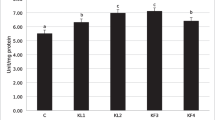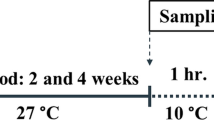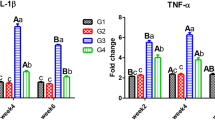Abstract
Backgrounds
There has been an increasing trend of copper (Cu)-based aquaculture industry in the world, and it is necessary to evaluate the effect of copper ion exposure on water pollution. This study was aim to determine the critical concentration of toxic copper in adult red sea bream.
Methods
Therefore, we investigated the effects of Cu toxicity on physiological stress and apoptosis exposed to various concentrations (10, 20, 30, and 40 μg/L). We measured physiological stress-related (corticotrophin- releasing hormone, adrenocorticotropic hormone, cortisol, and glucose), other toxic stress-related (metallothionein and Na+/K+-ATPase), and apoptosis-related (caspase-3 and hydrogen peroxide) parameters. In addition, we confirmed apoptosis.
Results
Physiological parameters were significantly increased from Cu concentration of 30 μg/L or more. However, no significant differences were observed after exposures at 10 and 20 μg/L. In addition, apoptotic cells were detected after exposure to 30 μg/L.
Conclusion
The results of this study indicate that high concentrations induce stress and apoptosis compared to normal conditions.
Similar content being viewed by others
References
Chen, Q. L. et al. Protective effects of calcium on copper toxicity in Pelteobagrus fulvidraco: Copper accumulation, enzymatic activities, histology. Ecotoxicol Environ Saf 76, 126–134 (2012).
Ren, G. et al. Characterisation of copper oxide nanoparticles for antimicrobial applications. Int J Antimicrob Agents 33, 587–590 (2009).
Luzio, A. et al. Copper induced upregulation of apoptosis related genes in zebrafish (Danio rerio) gill. Aquat Toxicol 128, 183–189 (2013).
Incheon metropolitan city hall. http://www.incheon. go.kr/program/fileDownload.do?file No=581105.pdf (2016).
Drach, A. Utilization of Copper Alloys for Marine Applications (Doctoral dissertation, University of New Hampshire, 2013).
Tellis, M. S., Alsop, D. & Wood, C. M. Effects of copper on the acute cortisol response and associated physiology in rainbow trout. Comp Biochem Physiol C 155, 281–289 (2012).
Jiang, W. D. et al. Copper exposure induces toxicity to the antioxidant system via the destruction of Nrf2/ARE signaling and caspase-3-regulated DNA damage in fish muscle: amelioration by myo-inositol. Aquat Toxicol 159, 245–255 (2015).
Glover, C. N., Urbina, M. A., Harley, R. A. & Lee, J. A. Salinity-dependent mechanisms of copper toxicity in the galaxiid fish, Galaxias maculatus. Aquat Toxicol 174, 199–207 (2016).
Gagnon, A., Jumarie, C. & Hontela, A. Effects of Cu on plasma cortisol and cortisol secretion by adrenocortical cells of rainbow trout (Oncorhynchus mykiss). Aquat Toxicol 78, 59–65 (2006).
Bonga, S. E. W. The stress response in fish. Physiol Rev 77, 591–625 (1997).
Flik, G. et al. CRF and stress in fish. Gen Comp Endocrinol 146, 36–44 (2006).
Begg, K. & Pankhurst, N. W. Endocrine and metabolic responses to stress in a laboratory population of the tropical damselfish, Acanthochromis polyacanthus. J Fish Biol 64, 133–145 (2004).
Small, B. C. Effect of isoeugenol sedation on plasma cortisol, glucose, and lactate dynamics in channel catfish Ictalurus punctatus exposed to three stressors. Aquaculture 238, 469–481 (2004).
Sampaio, F. G. et al. Antioxidant defenses and biochemical changes in the neotropical fish pacu, Piaractus mesopotamicus: Responses to single and combined copper and hypercarbia exposure. Comp Biochem Physiol C 156, 178–186 (2012).
Wu, S. M. et al. Analyzing the effectiveness of using branchial NKA activity as a biomarker for assessing waterborne copper toxicity in tilapia (Oreochromis mossambicus): A damage-based modeling approach. Aquat Toxicol 163, 51–59 (2015).
Carpenè, E., Andreani, G. & Isani, G. Metallothionein functions and structural characteristics. J Trace Elem Med Biol 21, 35–39 (2007).
Takahashi, S. Molecular functions of metallothionein and its role in hematological malignancies. J Hematol Oncol 5, 1 (2012).
Choi, Y. J. et al. Effects of waterborne selenium on toxic and physiological stress response in goldfish, Carassius auratus. Mol Cell Toxicol 11, 35–46 (2015).
Meena, B., Suresh, A., Sumit, R. & Mani, R. Induction of metallothionein with cadmium chloride in a economically important freshwater fish-grass carp, Ctenopharyngodon idella (valenciennes, 1844). Asian J Pharm Clin Res 8, 276–281 (2015).
Wu, S. M. Cortisol and Copper Induce Metallothionein Expression in Three Tissues of Tilapia (Oreochromis mossambicus) in Organ Culture. Zool stud 45, 363–370 (2006).
Mallatt, J. & Stinson, C. Toxicant extraction efficiency and branchial NaCl fluxes in lampreys exposed to Kepone. Arch Environ Contam Toxicol 19, 307–313 (1990).
McCormick, S. D., Regish, A. M. & Christensen, A. K. Distinct freshwater and seawater isoforms of Na+/K+-ATPase in gill chloride cells of Atlantic salmon. J Exp Biol 212, 3994–4001 (2009).
Schultz, A. G. et al. Silver nanoparticles inhibit sodium uptake in juvenile rainbow trout (Oncorhynchus mykiss). Environ Sci Technol 46, 10295–10301 (2012).
Alnemri, E. S. Mammalian cell death proteases: a family of highly conserved aspartate specific cysteine proteases. J Cell Biochem 64, 33–42 (1997).
Kerr, J. F., Wyllie, A. H. & Currie, A. R. Apoptosis: a basic biological phenomenon with wide-ranging implications in tissue kinetics. Br J Cancer 26, 239–257 (1972).
Hacker, G. The morphology of apoptosis. Cell Tissue Res 301, 5–17 (2000).
Monteiro, S. M. et al. Copper toxicity in gills of the teleost fish, Oreochromis niloticus: effects in apoptosis induction and cell proliferation. Aquat Toxicol 94, 219–228 (2009).
Roch, P. Defense mechanisms and disease prevention in farmed marine invertebrate. Aquaculture 172, 125–145 (1999).
An, K. W., Shin, H. S. & Choi, C. Y. Physiological responses and expression of metallothionein (MT) and superoxide dismutase (SOD) mRNAs in olive flounder, Paralichthys olivaceus exposed to benzo[a]pyrene. Comp Biochem Physiol B 149, 534–9 (2008).
Pandey, S. Biomarkers of oxidative stress: a comparative study of river Yamuna fish Wallago attu (Bl. & Schn.). Sci Total Environ 309, 105–115 (2003).
Nouroozzadeh, J., Tajaddini-Sarmadi, J. & Wolff, S. Measurement of Plasma Hydroperoxide Concentration by the Ferrous-Oxidation Xilenol Orange (FOX) Assay in Conjunction with Triphenilphosphine. Anal Biochem 220, 403–409 (1994).
Donaldson, E. M. & Dye, H. M. Corticosteroid concentrations in sockeye salmon (Oncorhynchus nerka) exposed to low concentrations of copper. Can J Fish Aquat Sci 32, 533–539 (1975).
Hedayati, A. & Ghaffari, Z. Evaluation of the Effects of Exposure to Copper Sulfate on some Eco-physiological Parameters in Silver Carp (Hypophthalmichthys molitrix). Iranian Journal of Toxicology 7, 887–893 (2013).
Olvera-Néstor, C. G. et al. Biomarkers of Cytotoxic, Genotoxic and Apoptotic Effects in Cyprinus carpio Exposed to Complex Mixture of Contaminants from Hospital Effluents. Bull Environ Contam Toxicol 96, 326–332 (2016).
de Souza Machado, A. A. et al. Biomarkers of waterborne copper exposure in the guppy Poecilia vivipara acclimated to salt water. Aquat Toxicol 138, 60–69 (2013).
Sevcikova, M. Metals as a cause of oxidative stress in fish: a review. Vet Med 56, 537–546 (2011).
Trivedi, M. H., Sangai, N. P. & Renuka, A. Assessment of toxicity of copper sulphate pentahydrate on oxidative stress indicators on liver of gold fish (Carassius auratus). Bull Environ Pharmacol Life Sci 1, 52–57 (2012).
Umasuthan, N. et al. A manganese superoxide dismutase (MnSOD) from Ruditapes philippinarum: Comparative structural-and expressional-analysis with copper/zinc superoxide dismutase (Cu/ZnSOD) and biochemical analysis of its antioxidant activities. Fish Shellfish Immunol 33, 753–765 (2012).
Li, J. et al. Effects of water-borne copper on branchial chloride cells and Na+/K+-ATPase activities in Mozambique tilapia (Oreochromis mossambicus). Aquat Toxicol 43, 1–11 (1998).
Mazon, A. F., Cerqueira, C. C. & Fernandes, M. N. Gill cellular changes induced by copper exposure in the South American tropical freshwater fish Prochilodus scrofa. Environ Res 88, 52–63 (2002).
Author information
Authors and Affiliations
Corresponding author
Rights and permissions
About this article
Cite this article
Kim, T.H., Choi, J.Y., Jung, MM. et al. Effects of waterborne copper on toxicity stress and apoptosis responses in red seabream, Pagrus major. Mol. Cell. Toxicol. 14, 201–210 (2018). https://doi.org/10.1007/s13273-018-0022-4
Received:
Accepted:
Published:
Issue Date:
DOI: https://doi.org/10.1007/s13273-018-0022-4




